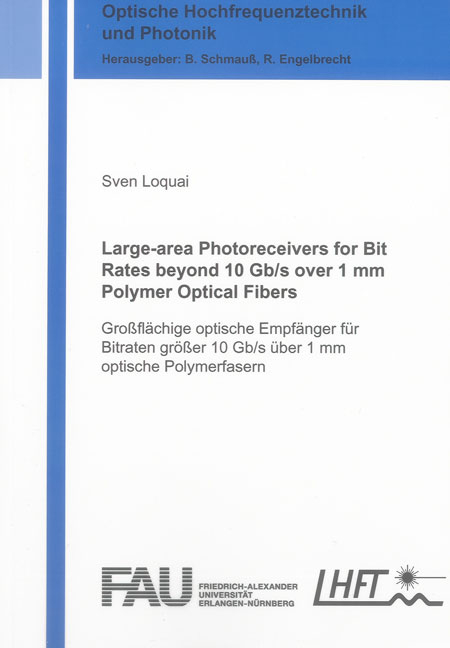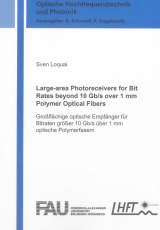Large-area Photoreceivers for Bit Rates beyond 10 Gb/s over 1 mm Polymer Optical Fibers
Großflächige optische Empfänger für Bitraten größer 10 Gb/s über 1 mm optische Polymerfasern
Seiten
2014
|
1., Aufl.
Shaker (Verlag)
978-3-8440-2552-1 (ISBN)
Shaker (Verlag)
978-3-8440-2552-1 (ISBN)
The use of large-core Ø 1 mm polymethyl methacrylate (PMMA) polymer optical fiber (POF) can be a promising alternative to conventional copper cables or multimode glass fiber applications. The large core diameter allows the use of simple plastic connectors or plug-less connections with even greater alignment tolerances which is acceptable for low cost consumer or some short reach industrial applications.
To reach bit rates of 10 Gb/s over PMMA POF, higher order modulation schemes had to be used. In practice, however, not the PMMA POF but the largearea photodetector is the main bottleneck since many years.
To investigate the potential of silicon PINphotodiodes for multi gigabit transmission over POF, a fully analytic PIN-photodiode model is derived that can easily be implemented in system simulation tools. This model also shows that data rates of 10 Gb/s at a desirable PINphotodiode diameter > 500 µm are difficult to realize.
MSM-detectors are potentially very promising for data transmission of high bit rates over Ø 1 mm PMMA POF because of a significantly lower capacitance per unit area. After a short introduction explaining the physics of an MSM-contact the time behavior of a standard MSMphotodetector is investigated. It has been found that the standard MSM-photodetector has a very low device capacitance but suffers from long carrier transit times. This often results in an even lower 3 dB bandwidth of a standard MSM-detector compared to a PINphotodiode.
After having successfully reduced the carrier transit times of the MSMdetectors three optical receivers were designed with an active diameter of 1000 µm, 700 µm and 400 µm. A 3 dB bandwidth of 7.8 GHz (Ø 1000 µm) to 8.6 GHz (Ø 700 µm) and 11 GHz (Ø 400 µm) was achieved. These are by far the best reported values for large-area visible light photoreceivers.
With these receivers a comparative study at 10.7 Gb/s over Ø 1 mm step-index (SI) or graded index (GI) PMMA POF is presented using various modulation schemes in combinations with equalizing techniques like non-return-to-zero modulation (NRZ), pulse amplitude modulation (PAM), discrete multitone modulation (DMT), feed-forward equalization (FFE), decision feedback equalization (DFE) and maximum likelihood sequence estimation (MLSE).
The study has shown that PAM in combination with electronic equalization seems to be a promising modulation format for future 10.7 Gb/s POF transmission systems. Based on this modulation scheme a record bit rate of 42 Gb/s is demonstrated over Ø 1 mm PMMA POF.
To reach bit rates of 10 Gb/s over PMMA POF, higher order modulation schemes had to be used. In practice, however, not the PMMA POF but the largearea photodetector is the main bottleneck since many years.
To investigate the potential of silicon PINphotodiodes for multi gigabit transmission over POF, a fully analytic PIN-photodiode model is derived that can easily be implemented in system simulation tools. This model also shows that data rates of 10 Gb/s at a desirable PINphotodiode diameter > 500 µm are difficult to realize.
MSM-detectors are potentially very promising for data transmission of high bit rates over Ø 1 mm PMMA POF because of a significantly lower capacitance per unit area. After a short introduction explaining the physics of an MSM-contact the time behavior of a standard MSMphotodetector is investigated. It has been found that the standard MSM-photodetector has a very low device capacitance but suffers from long carrier transit times. This often results in an even lower 3 dB bandwidth of a standard MSM-detector compared to a PINphotodiode.
After having successfully reduced the carrier transit times of the MSMdetectors three optical receivers were designed with an active diameter of 1000 µm, 700 µm and 400 µm. A 3 dB bandwidth of 7.8 GHz (Ø 1000 µm) to 8.6 GHz (Ø 700 µm) and 11 GHz (Ø 400 µm) was achieved. These are by far the best reported values for large-area visible light photoreceivers.
With these receivers a comparative study at 10.7 Gb/s over Ø 1 mm step-index (SI) or graded index (GI) PMMA POF is presented using various modulation schemes in combinations with equalizing techniques like non-return-to-zero modulation (NRZ), pulse amplitude modulation (PAM), discrete multitone modulation (DMT), feed-forward equalization (FFE), decision feedback equalization (DFE) and maximum likelihood sequence estimation (MLSE).
The study has shown that PAM in combination with electronic equalization seems to be a promising modulation format for future 10.7 Gb/s POF transmission systems. Based on this modulation scheme a record bit rate of 42 Gb/s is demonstrated over Ø 1 mm PMMA POF.
| Erscheint lt. Verlag | 7.2.2014 |
|---|---|
| Reihe/Serie | Optische Hochfrequenztechnik und Photonik |
| Sprache | englisch |
| Maße | 148 x 210 mm |
| Gewicht | 248 g |
| Einbandart | Paperback |
| Themenwelt | Technik ► Elektrotechnik / Energietechnik |
| Schlagworte | 10 Gbit/s • Data Transmission • Discrete Multi-tone Modulation (DMT) • Large-area Photodetector • Metal Semiconductor Metal (MSM) Detector • Modulation Schemes • Optical receiver • PIN-Photodiode • POF • polymer optical fiber • visible light |
| ISBN-10 | 3-8440-2552-9 / 3844025529 |
| ISBN-13 | 978-3-8440-2552-1 / 9783844025521 |
| Zustand | Neuware |
| Haben Sie eine Frage zum Produkt? |
Mehr entdecken
aus dem Bereich
aus dem Bereich
Kolbenmaschinen - Strömungsmaschinen - Kraftwerke
Buch | Hardcover (2023)
Hanser (Verlag)
49,99 €




